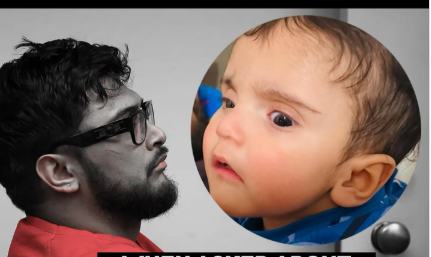The most vivid and eerie reminder of what unchecked abuse may become is still Carolina Haro. Her experience is eerily reminiscent of several underreported instances where early warning indicators were ignored in favor of inaction. Her life was drastically changed before it had started because she was Jake Haro’s daughter. She experienced what pediatric trauma specialists referred to as “catastrophic harm” at the age of 10 weeks, a set of injuries that were not only permanently damaging but also strongly symptomatic of systemic neglect.

According to medical reports, Carolina suffered particularly severe abuse, resulting in multiple fractures to her ribs, damage to her spine, and a fractured skull. She suffered severe damage to her soft tissues and brain hemorrhage. These injuries were caused by force, intent, and most importantly, repetition; they were not the consequence of a fall or a brief slip-up. Silence concealed this pattern, and forbearance misjudged it.
Jake Haro – Profile and Family Circumstances
| Attribute | Details |
|---|---|
| Full Name | Jake Mitchell Haro |
| Daughter’s Name | Carolina Haro |
| Daughter’s Status | Permanently bedridden; suffers from cerebral palsy after extreme abuse |
| Daughter’s Injuries | Fractured skull, broken ribs, spinal damage, brain hemorrhaging |
| Conviction (2023) | Pleaded guilty to willful child cruelty; received probation instead of prison |
| Legal Outcome | 6-year sentence suspended; granted probation and work release |
| Other Child | Emmanuel Haro (infant son, later declared murdered) |
| Current Legal Charges | Felony murder (Emmanuel), filing a false police report |
| Public Reaction | Vigorous outcry over sentencing leniency and institutional failure |
In 2023, Jake Haro’s admission of guilt was constructed around a plea deal, and prosecutors sought a prison sentence for him. Sam Taloa, the deputy district attorney, maintained that the child’s serious condition called for incarceration. Judge Dwight Moore of the Superior Court, however, saw an alternative course that was centered on reform and probationary deterrence. Moore said, “We have hung a very large hammer over the defendant’s head,” thinking that the prospect of further punishment would be enough. That decision seems dangerously permissive in retrospect, in addition to being wrong.
Carolina is unable to speak for herself because she is now bedridden. However, her medical records, which are remarkably detailed, show that she suffers from cerebral palsy, seizures, and severe neurological damage. She has constant needs. Her basic needs are met solely by caregivers. Because of the trauma she endured, her life has become a never-ending healing process that is unlikely to result in independence.
Following the subsequent tragedy involving her infant half-brother, Emmanuel Haro, the matter became very contentious. After detectives discovered obvious contradictions and signs of torture, Jake and Rebecca Haro were charged with criminal murder after fabricating a tale about a kidnapping. DA Mike Hestrin responded by emphatically pointing out that Emmanuel might still be alive if Jake had been imprisoned for the prior abuse of Carolina. The connection is demonstrable rather than just sentimental. Since there was never a clear break in the pattern of violence, it persisted.
The public’s attitude has drastically changed. Residents have lit candles and demanded justice for both Emmanuel and Carolina, whose pain was acknowledged by law but essentially disregarded, at vigils outside the Haros residence. Her story has become a rallying cry for child welfare professionals, serving as an illustration of what occurs when institutional trust takes the place of decisive action.
The case of Carolina demonstrates the extraordinary efficacy of child abuse detection when accompanied by action. Physicians were aware of the symptoms. The prosecution made their case quickly. However, a single judge’s ultimate judgment served as the turning point in the destiny of another kid.
In an interview conducted while incarcerated, Jake Haro keeps downplaying Carolina’s injuries. He asserts that the plea agreement was a legal tactic rather than an admission of guilt. However, the evidence is unwavering: forensic evaluations, trauma timelines, and medical scans have all created a remarkably resilient picture of abuse. In addition to disparaging Carolina’s lived experience, his dismissals run counter to the well recorded facts.
Carolina is now cited by advocacy organizations and legal experts as a compelling illustration of why prior mistreatment must be taken into consideration when making decisions in the future. Her injuries, which are quite obvious and permanently incapacitating, symbolize the trauma of multiple families and show how forgiving institutions can be when rehabilitation takes precedence over safety.
Some jurisdictions have started to reassess their risk assessments and sentencing procedures through strategic cooperation with pediatric hospitals and social workers. These conversations frequently bring up Carolina’s case, especially in training materials on judicial discretion and prosecutorial urgency.
Carolina’s body speaks for her even if she is unable to speak. The tendency to forget victims when the headlines fade is contested by her presence. She is a live record of what happens when judicial mercy is given too widely and too soon.
Her case warrants consideration in the light of more extensive judicial reform. Should a court be able to disregard medical evidence of serious abuse based just on hope? When a victim sustains lifelong brain damage, even if they survive, should probation ever be an option?
Media organizations and legal experts are changing the way society perceives partial justice by drawing fresh attention to victims like Carolina. There is no plea bargain at the end of this tale. It is a developing example of how a lack of responsibility leads to more harm. Carolina’s suffering highlights the systemic weaknesses that permitted violence to recur.
